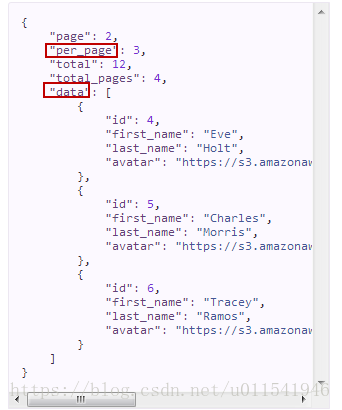您好,登錄后才能下訂單哦!
您好,登錄后才能下訂單哦!
在上篇文章,我們介紹了Get方法的設計過程和測試結果,現在我們需要對前面代碼進行重構和修改,本篇需要完成以下目標。
1.重構Get方法
在前面文章,說過,之前寫的Get方法比較繁瑣,不光寫了如何進行Get請求,還寫了獲取http響應狀態碼和JSON轉換。現在我們需要抽取出來,設計Get請求方法,就只干一件事情,那就是如何發送get請求,其他的不要管。
我們知道,請求之后會返回一個HTTP的響應對象,所以,我們把get方法的返回值類型改成了響應對象,并帶上返回語句,重構代碼之后,get方法代碼如下。
package com.qa.restclient;
import java.io.IOException;
import org.apache.http.client.ClientProtocolException;
import org.apache.http.client.methods.CloseableHttpResponse;
import org.apache.http.client.methods.HttpGet;
import org.apache.http.impl.client.CloseableHttpClient;
import org.apache.http.impl.client.HttpClients;
public class RestClient {
//1. Get 請求方法
public CloseableHttpResponse get(String url) throwsClientProtocolException, IOException {
//創建一個可關閉的HttpClient對象
CloseableHttpClienthttpclient = HttpClients.createDefault();
//創建一個HttpGet的請求對象
HttpGethttpget = newHttpGet(url);
//執行請求,相當于postman上點擊發送按鈕,然后賦值給HttpResponse對象接收
CloseableHttpResponsehttpResponse = httpclient.execute(httpget);
return httpResponse;
}
}
由于我們不想在代碼里寫死例如像HTTP響應狀態碼200這樣的硬編碼,所以,這里我們在TestBase.java里把狀態碼給用常量寫出來,方便每一個TestNG測試用例去調用去斷言。
package com.qa.base;
import java.io.FileInputStream;
import java.io.FileNotFoundException;
import java.io.IOException;
import java.util.Properties;
public class TestBase {
public Properties prop;
public int RESPNSE_STATUS_CODE_200 = 200;
public int RESPNSE_STATUS_CODE_201 = 201;
public int RESPNSE_STATUS_CODE_404 = 404;
public int RESPNSE_STATUS_CODE_500 = 500;
//寫一個構造函數
public TestBase() {
try{
prop= new Properties();
FileInputStreamfis = new FileInputStream(System.getProperty("user.dir")+
"/src/main/java/com/qa/config/config.properties");
prop.load(fis);
}catch (FileNotFoundException e) {
e.printStackTrace();
}catch (IOException e) {
e.printStackTrace();
}
}
}
現在我們的測試類代碼修改之后如下。
package com.qa.tests;
import java.io.IOException;
importorg.apache.http.client.ClientProtocolException;
importorg.apache.http.client.methods.CloseableHttpResponse;
import org.testng.Assert;
import org.testng.annotations.BeforeClass;
import org.testng.annotations.Test;
import com.qa.base.TestBase;
import com.qa.restclient.RestClient;
public class GetApiTest extends TestBase{
TestBase testBase;
String host;
String url;
RestClient restClient;
CloseableHttpResponse closeableHttpResponse;
@BeforeClass
public void setUp() {
testBase = new TestBase();
host = prop.getProperty("HOST");
url = host + "/api/users";
}
@Test
public void getAPITest() throws ClientProtocolException, IOException {
restClient = new RestClient();
closeableHttpResponse= restClient.get(url);
//斷言狀態碼是不是200
int statusCode = closeableHttpResponse.getStatusLine().getStatusCode();
Assert.assertEquals(statusCode,RESPNSE_STATUS_CODE_200, "response status code is not 200");
}
}
測試運行通過,沒毛病。
2.寫一個JSON解析的工具類
在上面部分,我們只是寫了執行Get請求和狀態碼是否200的斷言。接下來,我們需要寫有一個JSON解析工具類,這樣就方便我們去json內容的斷言。
下面這個JSON數據截圖

上面是一個標準的json的響應內容截圖,第一個紅圈”per_page”是一個json對象,我們可以根據”per_page”來找到對應值是3,而第二個紅圈“data”是一個JSON數組,而不是對象,不能直接去拿到里面值,需要遍歷數組。
下面,我們寫一個JSON解析的工具方法類,如果是像第一個紅圈的JSON對象,我們直接返回對應的值,如果是需要解析類似data數組里面的json對象的值,這里我們構造方法默認解析數組第一個元素的內容。
在src/main/java下新建一個包:com.qa.util,然后在新包下創建一個TestUtil.java類。
package com.qa.util;
import com.alibaba.fastjson.JSONArray;
import com.alibaba.fastjson.JSONObject;
public class TestUtil {
/**
*
* @param responseJson ,這個變量是拿到響應字符串通過json轉換成json對象
* @param jpath,這個jpath指的是用戶想要查詢json對象的值的路徑寫法
* jpath寫法舉例:1) per_page 2)data[1]/first_name ,data是一個json數組,[1]表示索引
* /first_name 表示data數組下某一個元素下的json對象的名稱為first_name
* @return,返回first_name這個json對象名稱對應的值
*/
//1 json解析方法
public static String getValueByJPath(JSONObject responseJson, String jpath){
Objectobj = responseJson;
for(String s : jpath.split("/")) {
if(!s.isEmpty()) {
if(!(s.contains("[") || s.contains("]"))) {
obj = ((JSONObject) obj).get(s);
}else if(s.contains("[") || s.contains("]")) {
obj =((JSONArray)((JSONObject)obj).get(s.split("\\[")[0])).get(Integer.parseInt(s.split("\\[")[1].replaceAll("]", "")));
}
}
}
return obj.toString();
}
}
簡單解釋下上面的代碼,主要是查詢兩種json對象的的值,第一種最簡單的,這個json對象在整個json串的第一層,例如上面截圖中的per_page,這個per_page就是通過jpath這個參數傳入,返回的結果就是3. 第二種jpath的查詢,例如我想查詢data下第一個用戶信息里面的first_name的值,這個時候jpath的寫法就是data[0]/first_name,查詢結果應該是Eve。
3.TestNG測試用例
下面,我們TestNG測試用例代碼如下
package com.qa.tests;
import java.io.IOException;
import org.apache.http.client.ClientProtocolException;
import org.apache.http.client.methods.CloseableHttpResponse;
import org.apache.http.util.EntityUtils;
import org.testng.Assert;
import org.testng.annotations.BeforeClass;
import org.testng.annotations.Test;
import com.alibaba.fastjson.JSON;
import com.alibaba.fastjson.JSONObject;
import com.qa.base.TestBase;
import com.qa.restclient.RestClient;
import com.qa.util.TestUtil;
public class GetApiTest extends TestBase{
TestBase testBase;
String host;
String url;
RestClient restClient;
CloseableHttpResponse closeableHttpResponse;
@BeforeClass
public void setUp() {
testBase = new TestBase();
host = prop.getProperty("HOST");
url = host + "/api/users?page=2";
}
@Test
public void getAPITest() throws ClientProtocolException, IOException {
restClient = new RestClient();
closeableHttpResponse = restClient.get(url);
//斷言狀態碼是不是200
int statusCode = closeableHttpResponse.getStatusLine().getStatusCode();
Assert.assertEquals(statusCode, RESPNSE_STATUS_CODE_200, "response status code is not 200");
//把響應內容存儲在字符串對象
String responseString = EntityUtils.toString(closeableHttpResponse.getEntity(),"UTF-8");
//創建Json對象,把上面字符串序列化成Json對象
JSONObject responseJson = JSON.parseObject(responseString);
//System.out.println("respon json from API-->" + responseJson);
//json內容解析
String s = TestUtil.getValueByJPath(responseJson,"data[0]/first_name");
System.out.println(s);
}
}
運行測試結果:
[RemoteTestNG] detected TestNGversion 6.14.3 Eve PASSED: getAPITest
你還可以多寫幾個jpath來測試這個json解析工具類。
String s = TestUtil.getValueByJPath(responseJson,"data[1]/id"); String s = TestUtil.getValueByJPath(responseJson,"per_page");
4.TestNG自帶的測試斷言方法
這里簡單提一下TestNG的斷言方法,我們一般測試都需要寫斷言的代碼,否則這樣的單元測試代碼就沒有意義。下面,我在statusCode和json解析的first_name進行斷言。
package com.qa.tests;
import java.io.IOException;
import org.apache.http.client.ClientProtocolException;
import org.apache.http.client.methods.CloseableHttpResponse;
import org.apache.http.util.EntityUtils;
import org.testng.Assert;
import org.testng.annotations.BeforeClass;
import org.testng.annotations.Test;
import com.alibaba.fastjson.JSON;
import com.alibaba.fastjson.JSONObject;
import com.qa.base.TestBase;
import com.qa.restclient.RestClient;
import com.qa.util.TestUtil;
public class GetApiTest extends TestBase{
TestBase testBase;
String host;
String url;
RestClient restClient;
CloseableHttpResponse closeableHttpResponse;
@BeforeClass
public void setUp() {
testBase = new TestBase();
host = prop.getProperty("HOST");
url = host + "/api/users?page=2";
}
@Test
public void getAPITest() throws ClientProtocolException, IOException {
restClient = new RestClient();
closeableHttpResponse = restClient.get(url);
//斷言狀態碼是不是200
int statusCode = closeableHttpResponse.getStatusLine().getStatusCode();
Assert.assertEquals(statusCode, RESPNSE_STATUS_CODE_200, "response status code is not 200");
//把響應內容存儲在字符串對象
String responseString = EntityUtils.toString(closeableHttpResponse.getEntity(),"UTF-8");
//創建Json對象,把上面字符串序列化成Json對象
JSONObject responseJson = JSON.parseObject(responseString);
//System.out.println("respon json from API-->" + responseJson);
//json內容解析
String s = TestUtil.getValueByJPath(responseJson,"data[0]/first_name");
System.out.println(s);
Assert.assertEquals(s, "Eve","first name is not Eve");
}
}
經常使用的測試斷言:
Assert.assertEquals(“現實結果”, "期待結果","斷言失敗時候打印日志消息");
以上就是本文的全部內容,希望對大家的學習有所幫助,也希望大家多多支持億速云。
免責聲明:本站發布的內容(圖片、視頻和文字)以原創、轉載和分享為主,文章觀點不代表本網站立場,如果涉及侵權請聯系站長郵箱:is@yisu.com進行舉報,并提供相關證據,一經查實,將立刻刪除涉嫌侵權內容。